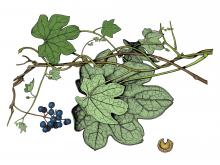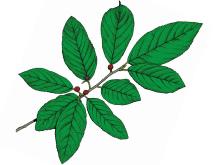Trees, Shrubs and Woody Vines
Media

Species Types
Scientific Name
Cocculus carolinus
Description
Carolina moonseed is a slender, twining vine. It is scattered in southern and eastern Missouri. It bears clusters of bright red, somewhat flattened fruits. The disk-shaped seeds are spiraled like a snail shell.
Media

Species Types
Scientific Name
Menispermum canadense
Description
Common moonseed is a rather slender, twining vine that climbs or sprawls. It occurs nearly statewide. It bears clusters of bluish-black fruits. The seeds are flattened, with a raised edge shaped like a crescent moon.
Media

Species Types
Scientific Name
Calycocarpum lyonii
Description
Cupseed is a relatively stout, robust twining vine that dies back to the ground in severe winters. It is scattered south of the Missouri River. It bears clusters of black fruits. The seeds are shaped like little cups.
Media

Species Types
Scientific Name
Zanthoxylum americanum
Description
Common prickly ash is a thicket-forming shrub or small tree. Its compound leaves resemble of those of ash trees, but it’s in a different family. Pairs of stout, curved prickles occur at each node. Scattered statewide, but less common in the Ozarks.
Media

Species Types
Scientific Name
Rhamnus caroliniana (syn. Frangula caroliniana)
Description
Carolina buckthorn occurs in the southeastern half of Missouri. It’s a shrub with several main stems, or a small tree potentially reaching 40 feet high, with a trunk diameter of up to 8 inches. Despite the name, there are no thorns.
Media

Species Types
Scientific Name
Rubus occidentalis
Description
Black raspberries resemble blackberries, but when ripe, the fruits fall away as a caplike unit from the receptacle. Leaflets appear white underneath. The canes are whitish-coated when young; they arch down and take root at the tips. Native and scattered statewide.
See Also
About Trees, Shrubs and Woody Vines in Missouri
There are no sharp dividing lines between trees, shrubs, and woody vines, or even between woody and nonwoody plants. “Wood” is a type of tissue made of cellulose and lignin that many plants develop as they mature — whether they are “woody” or not. Trees are woody plants over 13 feet tall with a single trunk. Shrubs are less than 13 feet tall, with multiple stems. Vines require support or else sprawl over the ground.





















